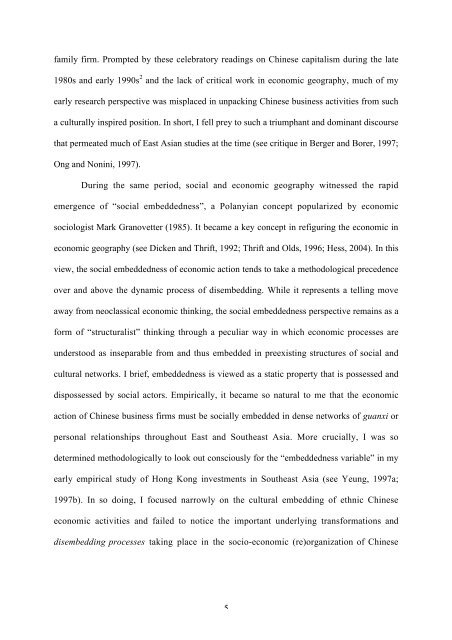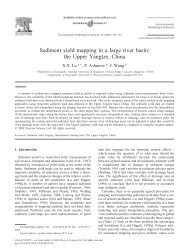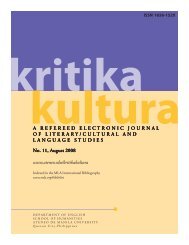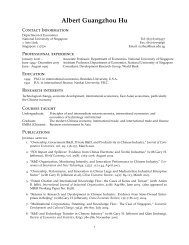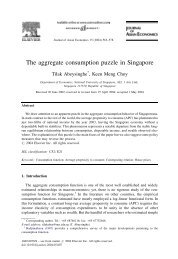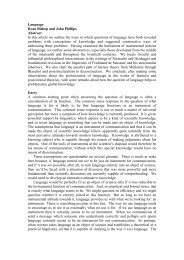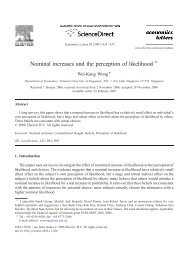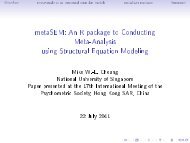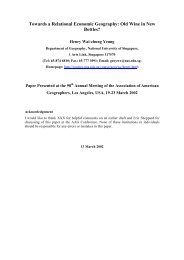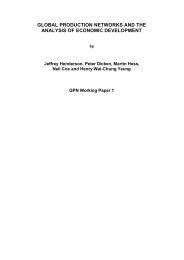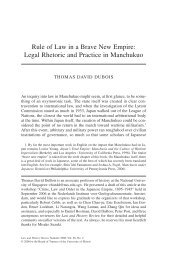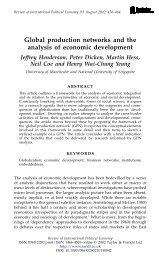Researching Hybridity in Social and Economic ... - NUS Home
Researching Hybridity in Social and Economic ... - NUS Home
Researching Hybridity in Social and Economic ... - NUS Home
Create successful ePaper yourself
Turn your PDF publications into a flip-book with our unique Google optimized e-Paper software.
family firm. Prompted by these celebratory read<strong>in</strong>gs on Ch<strong>in</strong>ese capitalism dur<strong>in</strong>g the late<br />
1980s <strong>and</strong> early 1990s 2 <strong>and</strong> the lack of critical work <strong>in</strong> economic geography, much of my<br />
early research perspective was misplaced <strong>in</strong> unpack<strong>in</strong>g Ch<strong>in</strong>ese bus<strong>in</strong>ess activities from such<br />
a culturally <strong>in</strong>spired position. In short, I fell prey to such a triumphant <strong>and</strong> dom<strong>in</strong>ant discourse<br />
that permeated much of East Asian studies at the time (see critique <strong>in</strong> Berger <strong>and</strong> Borer, 1997;<br />
Ong <strong>and</strong> Non<strong>in</strong>i, 1997).<br />
Dur<strong>in</strong>g the same period, social <strong>and</strong> economic geography witnessed the rapid<br />
emergence of “social embeddedness”, a Polanyian concept popularized by economic<br />
sociologist Mark Granovetter (1985). It became a key concept <strong>in</strong> refigur<strong>in</strong>g the economic <strong>in</strong><br />
economic geography (see Dicken <strong>and</strong> Thrift, 1992; Thrift <strong>and</strong> Olds, 1996; Hess, 2004). In this<br />
view, the social embeddedness of economic action tends to take a methodological precedence<br />
over <strong>and</strong> above the dynamic process of disembedd<strong>in</strong>g. While it represents a tell<strong>in</strong>g move<br />
away from neoclassical economic th<strong>in</strong>k<strong>in</strong>g, the social embeddedness perspective rema<strong>in</strong>s as a<br />
form of “structuralist” th<strong>in</strong>k<strong>in</strong>g through a peculiar way <strong>in</strong> which economic processes are<br />
understood as <strong>in</strong>separable from <strong>and</strong> thus embedded <strong>in</strong> preexist<strong>in</strong>g structures of social <strong>and</strong><br />
cultural networks. I brief, embeddedness is viewed as a static property that is possessed <strong>and</strong><br />
dispossessed by social actors. Empirically, it became so natural to me that the economic<br />
action of Ch<strong>in</strong>ese bus<strong>in</strong>ess firms must be socially embedded <strong>in</strong> dense networks of guanxi or<br />
personal relationships throughout East <strong>and</strong> Southeast Asia. More crucially, I was so<br />
determ<strong>in</strong>ed methodologically to look out consciously for the “embeddedness variable” <strong>in</strong> my<br />
early empirical study of Hong Kong <strong>in</strong>vestments <strong>in</strong> Southeast Asia (see Yeung, 1997a;<br />
1997b). In so do<strong>in</strong>g, I focused narrowly on the cultural embedd<strong>in</strong>g of ethnic Ch<strong>in</strong>ese<br />
economic activities <strong>and</strong> failed to notice the important underly<strong>in</strong>g transformations <strong>and</strong><br />
disembedd<strong>in</strong>g processes tak<strong>in</strong>g place <strong>in</strong> the socio-economic (re)organization of Ch<strong>in</strong>ese<br />
5


